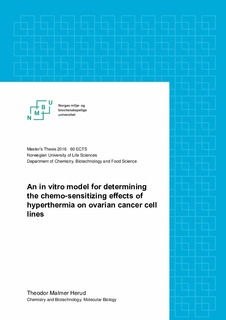| dc.contributor.advisor | Lea, Tor Erling | |
| dc.contributor.advisor | Andersson, Yvonne | |
| dc.contributor.author | Herud, Morten Theodor Malmer | |
| dc.date.accessioned | 2017-09-27T11:22:03Z | |
| dc.date.available | 2017-09-27T11:22:03Z | |
| dc.date.issued | 2017 | |
| dc.identifier.uri | http://hdl.handle.net/11250/2457050 | |
| dc.description.abstract | Ovarian cancers, the deadliest of gynecological malignancies, claim the lives of 300 Norwegian women every year. The disease is characterized by late stage detection and the majority of patients present peritoneal metastases upon first diagnosis. Conventional treatment consists of cytoreductive surgery and intravenous chemotherapy, but treatment is ineffective at removing all residual disease and the majority of patients relapse, resulting in 5-year survival rates less than 34%.
Hyperthermic intraperitoneal chemotherapy (HIPEC) is a method constructed to remove microscopic metastases and free cancer cells within the peritoneal cavity after cytoreductive surgery. The procedure involves circulating heated chemotherapy directly into the peritoneal cavity, and clinical trials on metastatic ovarian cancer have shown survival benefit. However, few studies have investigated the effect hyperthermia has on cancer cells during HIPEC, and limited knowledge prevents improvements to the HIPEC procedure and drug selection.
During this master thesis we established an in vitro model replicating the clinical conditions of HIPEC. The aim was to investigate the effects of hyperthermia treatment combined with chemotherapy or immunotoxin on the viability, apoptosis and cell cycle distribution of ovarian cancer cell lines. Viability was assessed with MTS-assay, while TUNEL-assay and Hoechst DNA-stain was used to analyze apoptosis and cell cycle distribution by flow cytometry. Expression levels of HSP70 were investigated using PeggySue™ technology, as HSP70 expression has been linked to therapy resistance.
The results show that hyperthermia can sensitize cells to chemotherapy, but the extent of this effect varies among the cell lines. The cell line OVCA432 had highest resistance based on viability measurements, while also having the highest increase in HSP70 expression after hyperthermia. Of the three chemotherapy agents included in this study, the effect of cisplatin was most frequently potentiated by hyperthermia. We also found the carboplatin-resistant cell line B76 to be sensitized by hyperthermia during analysis of apoptosis. The immunotoxin MOC31PE was the only agent showing hyperthermia sensitization in all cell lines. Limitations of the model include the use of viability assays to determine cell response, as well as cell cultures. These limitations can be resolved by incorporating ex-vivo patient samples or animal models, and by including several methods of analyzing treatment response. Our findings show that the sensitizing effect of hyperthermia may depend on the patient-specific tumor profile. Future studies should aim to investigate candidate genes for the resistance observed in cell lines OVCA433 and OVCA432, which could facilitate development of strategies that reverse treatment resistance, and improve the selection of drugs which benefit from HIPEC administration. | nb_NO |
| dc.description.abstract | I Norge dør omlag 300 kvinner hvert år av eggstokk-kreft. Sykdommen er vanskelig å oppdage og vil i de fleste tilfeller være på avansert stadium ved første diagnose. Avansert eggstokk-kreft danner ofte metastaser i bukhulen, og ordinær behandling består av avansert kirurgi og systemisk kjemoterapi. Dessverre er slik behandling lite effektiv og en stor andel pasienter vil få tilbakefall som følge av gjenværende kreftceller, noe som fører til en svært lav 5-års overlevelsesrate.
Hypertermisk intraperitoneal kjemoterapi (HIPEC) er en unik metode satt sammen for å behandle mikroskopiske tumorer og frie kreftceller i bukhulen etter kirurgi. Metoden benytter oppvarmet cellegift som sirkuleres direkte i bukhulen, og kliniske forsøk på pasienter med peritoneal spredning av eggstokk-kreft har vist økt overlevelsesrate. Likevel er det svært få pre-kliniske studier som undersøker hvordan kombinasjonsbehandling med hypertermi påvirker kreftceller på et molekylært nivå, og manglende kunnskap gjør det vanskelig å forbedre det kliniske utfallet til HIPEC.
I denne masteroppgaven etablerte vi en in vitro modell som etterlikner forholdene under en HIPEC-prosedyre. Målet var å undersøke om kombinasjonsbehandling med hypertermi og cellegift eller immunotoksin kunne påvirke levedyktighet, celledød og cellesyklus i ovariekreft-cellelinjer. MTS viabilitets-assay ble benyttet for å undersøke levedyktighet etter behandling, mens TUNEL apoptose-assay og Hoechst-DNA farging ble brukt til å undersøke celledød og cellesyklus-distribusjon gjennom flow cytometri. I tillegg ble ekspresjonsnivået av HSP70 undersøkt i cellelinjene ved bruk av PeggySue™ teknologi, ettersom proteinet tidligere har blitt knyttet til terapi-resistens.
Forsøksresultatene viste at hypertermi kan øke effekten av cellegift, men at denne effekten varierer avhengig av cellelinje. Cellelinjen OVCA432 hadde høy resistens basert på viabilitetsmålinger, og hadde høyest økning i HSP70 ekspresjon etter hypertermi. Av de tre cellegiftene var det cisplatin som oftest viste synergi i kombinasjon med hypertermi, mens immunotoksinet MOC31PE var det eneste middelet som viste synergi med hypertermi i alle cellelinjene. Den carboplatin-resistente cellelinjen B76 ble sensitiv mot carboplatin i kombinasjon med hypertermi. For å verifisere in vitro resultater kan ex-vivo pasientmateriale og dyremodeller inkorporeres i fremtidige forsøk, samt ulike teknikker for å undersøke celledød etter behandling. Videre forsking på kartlegging av gener som underbygger den observerte resistensen til OVCA433 eller OVCA432 kan bidra til å utvikle strategier som reverser terapi-resistens, samt forbedre selektsjon av cellegifter som drar nytte av hypertermi. | nb_NO |
| dc.language.iso | eng | nb_NO |
| dc.publisher | Norwegian University of Life Sciences, Ås | nb_NO |
| dc.rights | Attribution-NonCommercial-NoDerivatives 4.0 Internasjonal | * |
| dc.rights.uri | http://creativecommons.org/licenses/by-nc-nd/4.0/deed.no | * |
| dc.subject | HIPEC | nb_NO |
| dc.title | An in vitro model for determining the chemo-sensitizing effects of hyperthermia on ovarian cancer cell lines | nb_NO |
| dc.type | Master thesis | nb_NO |
| dc.source.pagenumber | 96 | nb_NO |
| dc.description.localcode | M-BIOTEK | nb_NO |

